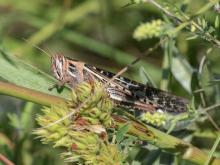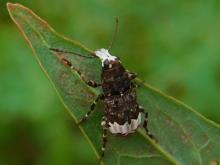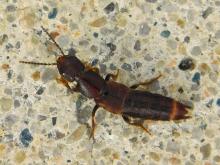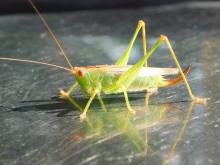Land Invertebrates
Media

Species Types
Scientific Name
Cicindela limbalis
Description
The common claybank tiger beetle, or green-margined tiger beetle, occurs on dirt clay soils in open areas in spring and, less abundantly, in late summer. Color varies from red to purple to green. The outer shell edges are often edged with shiny green.
Media

Species Types
Scientific Name
Schistocerca americana
Description
The American bird grasshopper is a large grasshopper with ornate markings. It is a good flier that floats upward into trees. Note the pale stripe running down the back.
Media

Species Types
Scientific Name
About 120 species in North America north of Mexico
Description
Fungus weevils are a family of beetles that differ from other weevils by their broad, flat bills and clubbed, but not elbowed, antennae. It's a diverse group, but many do feed on bracket mushrooms and other fungi.
Media

Species Types
Scientific Name
Myzinum quinquecinctum
Description
Female and male five-banded thynnid wasps look quite different. Both are banded with black and yellow, but the females are large and heavy-looking, while the males, often seen in groups, are much skinnier and have a scythe-shaped false stinger on the hind end.
Media

Species Types
Scientific Name
Vespa crabro
Description
The European hornet is a large, nonnative hornet that was introduced to New York in the mid-1800s. They now occur across most of the eastern United States, including Missouri. People may misidentify them as the highly publicized, so-called murder hornets.
Media

Species Types
Scientific Name
Pachypsylla spp.
Description
Hackberry psyllids are a genus of tiny, planthopper-like bugs. As larvae, they develop within the leaves, twigs, buds, or bark of hackberry trees. The trees form warty galls in response to their presence. In the fall, tiny adult hackberry psyllids cling to window screens.
Media

Species Types
Scientific Name
More than 4,400 species in North America north of Mexico
Description
Rove beetles usually have very short wing covers, so several of their hind abdominal segments are exposed. Typically fast movers, they often flip up their abdomen tips when frightened. This is a huge family of beetles.
Media

Species Types
Scientific Name
Apis mellifera
Description
The honeybee is a major pollinator of many field crops and tree fruits. Native to the Old World, it is not native to North America. In 1985 it was named the official state insect of Missouri.
Media

Species Types
Scientific Name
About 250 species in North America north of Mexico
Description
Katydids are a family of insects that may also be called longhorned grasshoppers, because of their super-long antennae. Many resemble green leaves. Others are brown. Members of some species may be bright pink or yellow.
Media

Species Types
Scientific Name
Orchelimum vulgare
Description
The common meadow katydid is aptly named: it is well-known and widespread in the eastern United States. Listen for its distinctive call — like a pulsating circular lawn sprinkler ratcheting around — in midsummer to the first hard frost.
See Also



Media

Species Types
Scientific Name
Cisseps fulvicollis
Description
The yellow-collared scape moth is more often “orange-collared.” And whether you think it looks more like a firefly or a wasp, it’s still a moth!
Media

Species Types
Scientific Name
Nearly 150 species in North America north of Mexico
Description
Slim, delicate plume moths are instantly recognizable by their T-shaped silhouette, long legs, and muted shades of tan and brown. It can be hard to separate the various species.
Media

Species Types
Scientific Name
Pyrrharctia isabella
Description
Not many people know the adult Isabella tiger moth when they see one, but we’re all acquainted with its caterpillar, the woolly worm, or woolly bear.
About Land Invertebrates in Missouri
Invertebrates are animals without backbones, including earthworms, slugs, snails, and arthropods. Arthropods—invertebrates with “jointed legs” — are a group of invertebrates that includes crayfish, shrimp, millipedes, centipedes, mites, spiders, and insects. There may be as many as 10 million species of insects alive on earth today, and they probably constitute more than 90 percent all animal species.





















